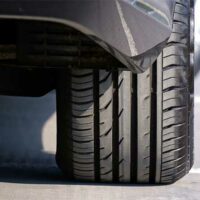The Essentials of Tire Safety

Most of us do not put much thought into our tires. In fact, the only time we might is when we have an oil change and the technician recommends a tire rotation.
Tires are an essential component of your overall vehicle safety. Therefore, they are something you should not just consider here and there. When you care for tires correctly, you will not only keep your vehicle (and the passengers in that vehicle) safe, but you reap the other benefits like better performance, handling, and fewer trips to the gas station for fill-ups.
Tire Care Essentials for Sunrise Residents
All it takes is a few extra minutes each month to ensure your tires are safe enough for travel – and you do not need to be an expert mechanic or have any special tools either.
From pressure to tread to the rotation, here are a few things to consider with your tires.
Tire Pressure
Tire pressure refers to your tire inflation levels, and it is one of the most important conditions to monitor on a vehicle. Proper inflation is what gives your tire the ability to control the car, support the weight of your car, and provides you with maximum performance while braking, accelerating, and turning.
An even better benefit is that inflation maximizes your fuel economy, which means fewer trips to the gas station and more money in your pocket.
Here is how inflation affects your vehicle:
-
Under-Inflated Tires – When tire pressure falls below the recommended pressure point set by the manufacturer, you create excessive stress and heat build-up for the tire. This forces irregular wear and tear patterns, internal damage, and decreases the lifespan of your tires significantly.
-
Over Inflated Tires – Over inflation is equally as dangerous. In this case, your tires are at higher risk for puncture, cuts, or damage if you were to hit an obstacle – even a small pothole.
Know How to Check Your Tire Pressure
Checking your tire pressure is relatively easy. All it takes is a tire gauge. Gauges use PSI (pounds per square inch), and your manufacturer sets the recommended PSI for your vehicle. You can check this by reading the label affixed to the driver’s side door or your vehicle manual.
Ideally, you should check tire pressure weekly and check your spare tire at least once per month to adjust air inflation as needed.
Note that pressure increases in warmer weather and decreases in colder weather. If you have had a recent temperature fluctuation, recheck the pressure just in case.
Tread Depths
Tread depths are what determine how much traction you get from a tire. The more tread you have, the more grip you will keep on the road, especially in slick conditions.
Each month you need to check your tire tread. Once the tread drops to 2/32nds of an inch, it is time to replace your tires. When you check your tires each month; look for bald areas, uneven wear, tears, high and low spots, or unusually smooth areas that indicate less tread.
Today, manufacturers include wear indicators (known as tread bars) on their tires. Once the top of the bar is flush with the rest of your tire’s tread, you need a replacement tire.
Tire Rotations
Tire rotations ensure even wear and tear on your tires and prevents you from having to replace them prematurely. Look at your owner’s manual to see how often you should rotate your tires. If there is no recommendation in the handbook, rotate every 5,000 to 8,000 miles.
Once the tires have been rotated and balanced, you still should check tire pressure monthly and inspect them. Even with regular rotations, the tread can wear down quickly – more so depending on your driving style.
Make sure when you have the tires rotated they are also balanced. A properly balanced set of tires prevents uneven wear and gives your tires maximum lifespan. To balance tires, your technician uses small weights that they attach to each wheel to stop vibrations in the wheels as they turn. You should always have balancing performed when you install new tires and any time you notice vibrations while you drive. Also, if you have a tire repaired (such as an air leak), make sure it is re-balanced.
Tire Alignments
Alignments are an easily overlooked area of tire safety but should be at the top of your priority list. If you hit potholes or drive on uneven, rocky pavement, you could have alignment issues. A misaligned tire leads to faster, more uneven wear on the tread, and that means more tire replacements in your future.
Some indications you need an alignment:
- Your vehicle is pulling to the left or right.
- You have uneven, rapid tire wear on one side of the vehicle.
- Your steering wheel remains crooked even though you are driving straight.
- You hear a squealing noise from your tires.
There are no warning indicators on the dash telling you it is time for an alignment. Therefore, you need to look out for these common signs and have your alignment checked. An alignment appointment takes just a few minutes and saves you hundreds in the long run.
When Faulty Tires Cause Accidents
Sometimes, car accidents happen because owners fail to maintain their tires. Other times, the manufacturer of the tire has released a defective product. Regardless, when you are in an accident caused by someone’s negligence, you have the right to hold them accountable.
You need to meet with an attorney right away to discuss your case. An accident attorney will review the facts and determine which party may be responsible (such as the driver, technician that installed your tires, or the company that made the tire).
If you suspect your accident was the fault of someone else, contact The Law Offices of David M. Benenfeld P.A. today. You can schedule a free, no-obligation consultation today at 954-677-0155 or request more information online.

